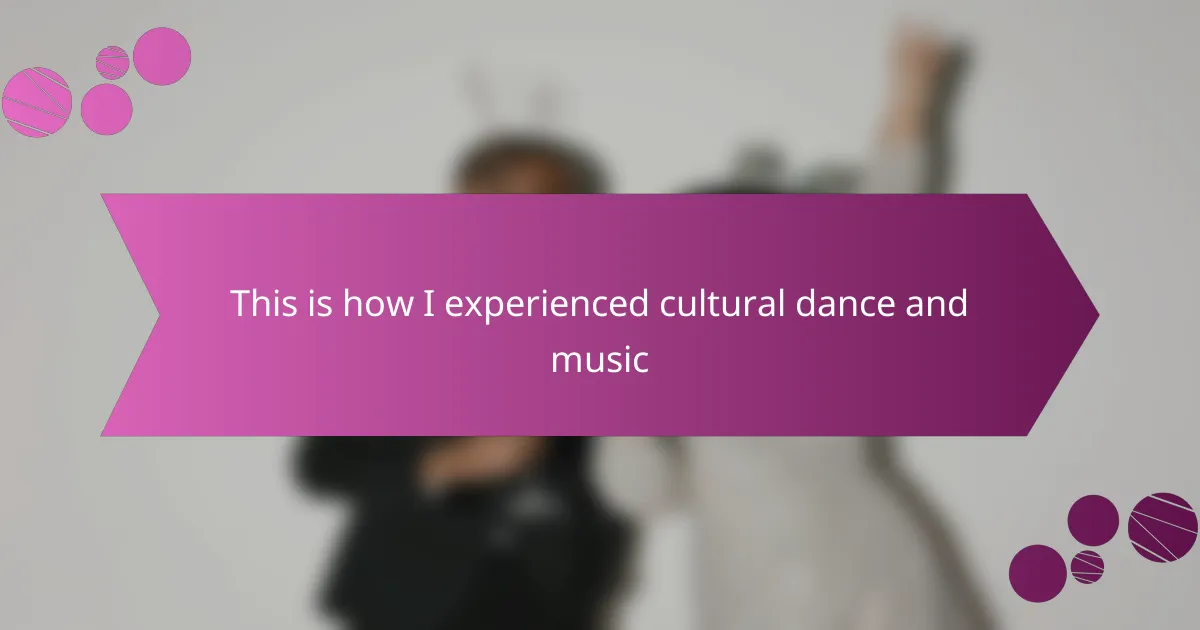Key takeaways
- Thai music festivals celebrate the country’s rich cultural heritage through traditional instruments, dance, and communal engagement.
- Cultural dance serves as a powerful expression of heritage, connecting present generations to their ancestors and fostering community bonds.
- Key genres like luk thung and mor lam highlight the storytelling aspect of Thai music, blending traditional themes with modern influences.
- Traditional dance performances, such as Ram Thai, showcase intricate movements and colorful costumes, enhancing the emotional connection to Thai culture.
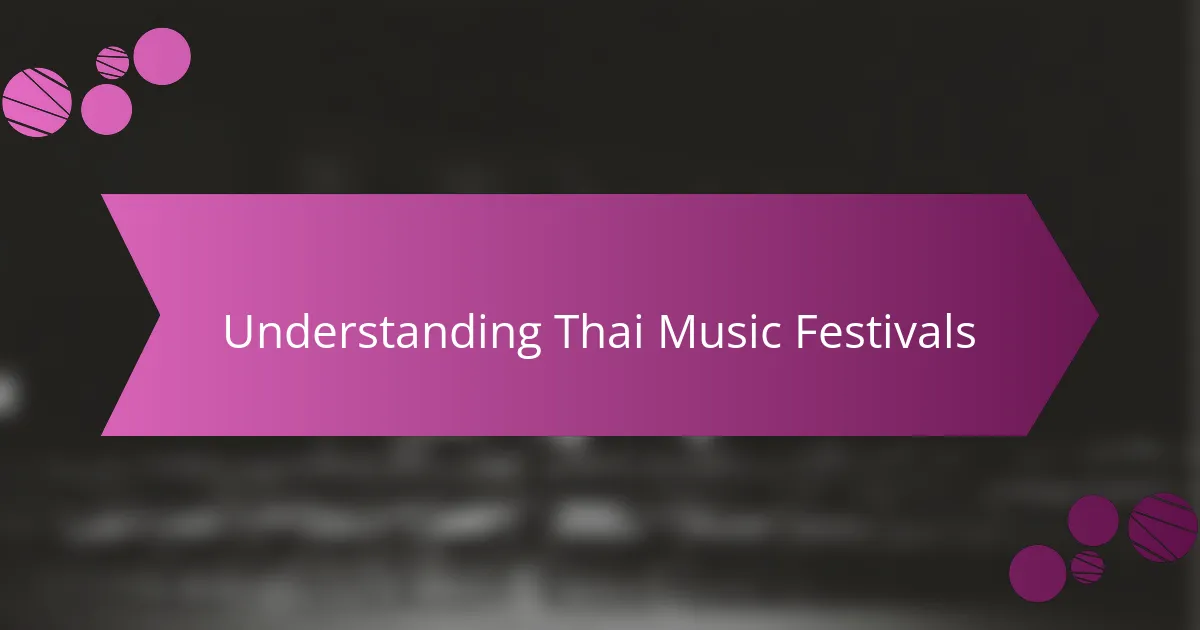
Understanding Thai music festivals
Thai music festivals are vibrant cultural experiences that celebrate the rich heritage of Thailand through lively performances. I remember my first visit to a local festival; the colors, the rhythm of the drumbeats, and the warmth of the crowd created an atmosphere that felt like a journey through time. Each performance was not just a show; it was a story, expressing emotions that pulled at my heartstrings.
These festivals often feature traditional instruments like the khim, a type of hammered dulcimer, and the ranat, which is similar to a xylophone. The communal spirit felt during these gatherings is truly something special. I found myself swaying along as dancers adorned in elaborate costumes moved gracefully to tunes that resonated deeply with the audience.
Here’s a comparison table highlighting some key elements of Thai music festivals:
| Element | Description |
|---|---|
| Instruments | Traditional instruments like khim and ranat are often featured. |
| Dance | Dance performances tell stories of Thai culture and history. |
| Atmosphere | A communal spirit where the audience actively participates and engages. |
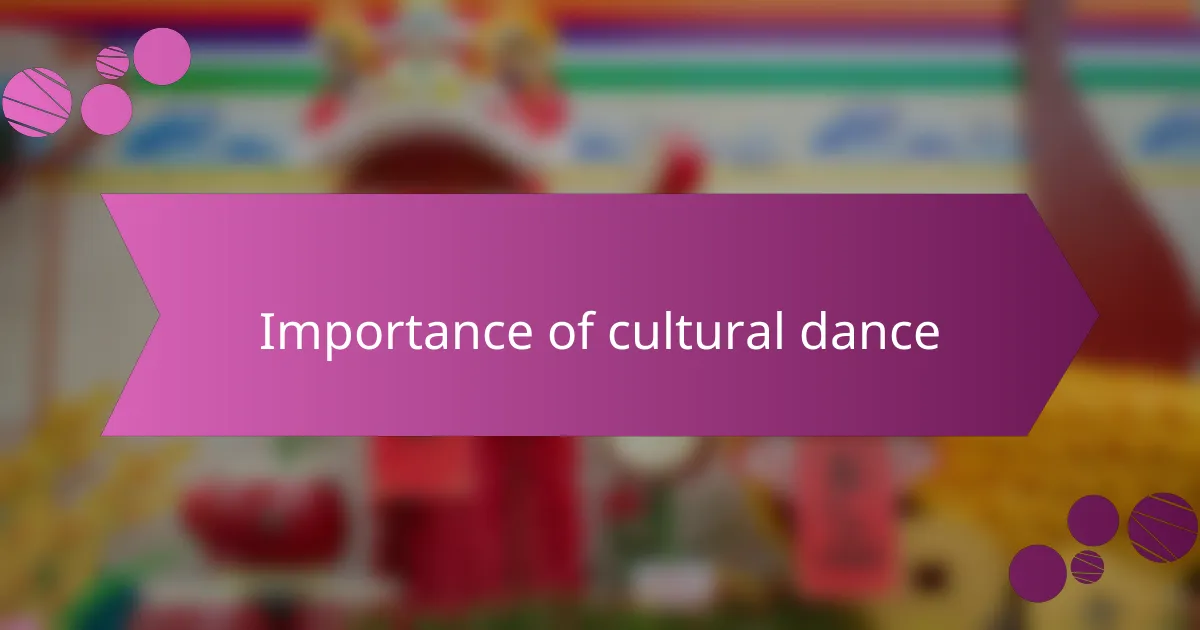
Importance of cultural dance
Cultural dance is more than just movement; it’s a powerful expression of heritage and identity. I remember my first encounter with traditional Thai dance at a local festival. The intricate costumes and graceful movements told stories that transcended language, creating a deep emotional connection for everyone watching.
Throughout my experience, I’ve realized how crucial cultural dance is in preserving traditions. It fascinates me that each gesture has significance, linking the present to ancestors and their beliefs. This connection fosters a sense of community and belonging among participants and spectators alike.
Here’s a comparison of cultural dance versus contemporary dance, which highlights their distinct characteristics:
| Aspect | Cultural Dance | Contemporary Dance |
|---|---|---|
| Purpose | Express heritage and tradition | Personal expression and exploration |
| Styles | Structured, often ritualistic | Freeform, varied styles |
| Community Impact | Strengthens cultural identity | Promotes individual creativity |
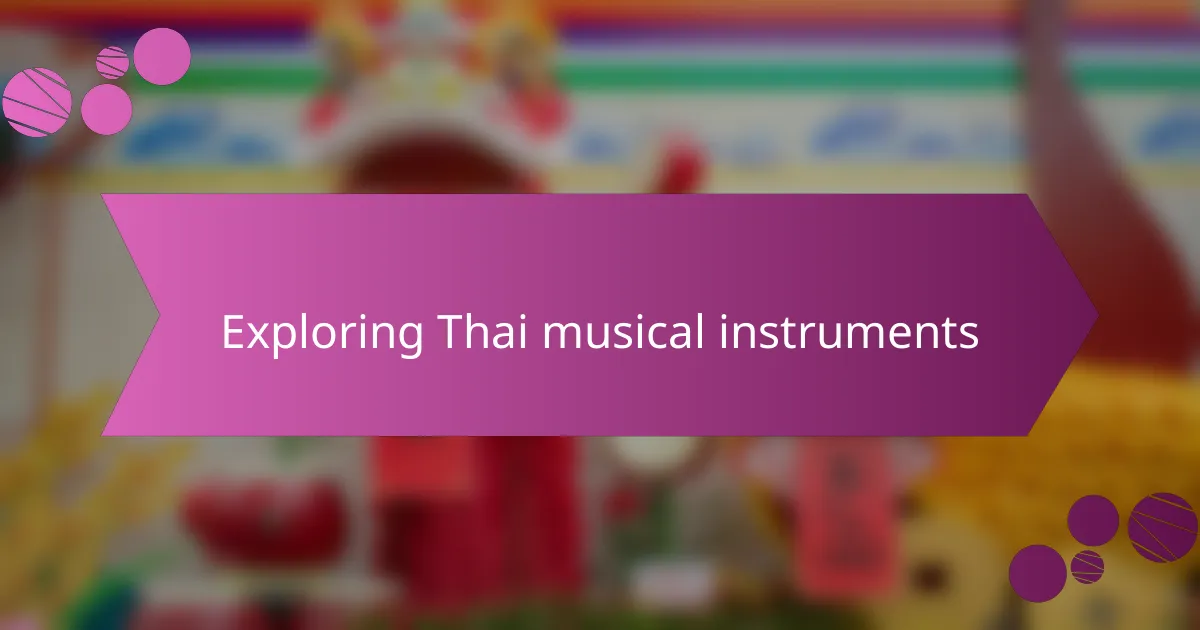
Exploring Thai musical instruments
Visiting a Thai music festival truly opened my eyes to the rich tapestry of musical instruments that embody the culture. The sound of the ranat ek, a traditional xylophone made of wood, resonates deeply, carrying melodies that evoke a sense of nostalgia for simpler times. I can still remember the moment I first heard it in a live performance—its warm tones seemed to reach right into my heart.
During the festival, I also encountered instruments like the khim, a hammered dulcimer that offers a distinctly haunting sound. Each stroke of the mallet brought me closer to the essence of Thai heritage. The energy of the musicians and their deep connection to the instruments made every note feel palpable, almost as if they were sharing their stories with the audience.
- Ranat ek: A wooden xylophone known for its rich, melodious sound.
- Khim: A hammered dulcimer that produces a resonant and enchanting tone.
- Saw u: A two-stringed fiddle that delivers both haunting and joyful music.
- Phin: A traditional lute that adds vibrant flair to folk music.
- Ching: Small cymbals that create a rhythmic backdrop to a variety of performances.
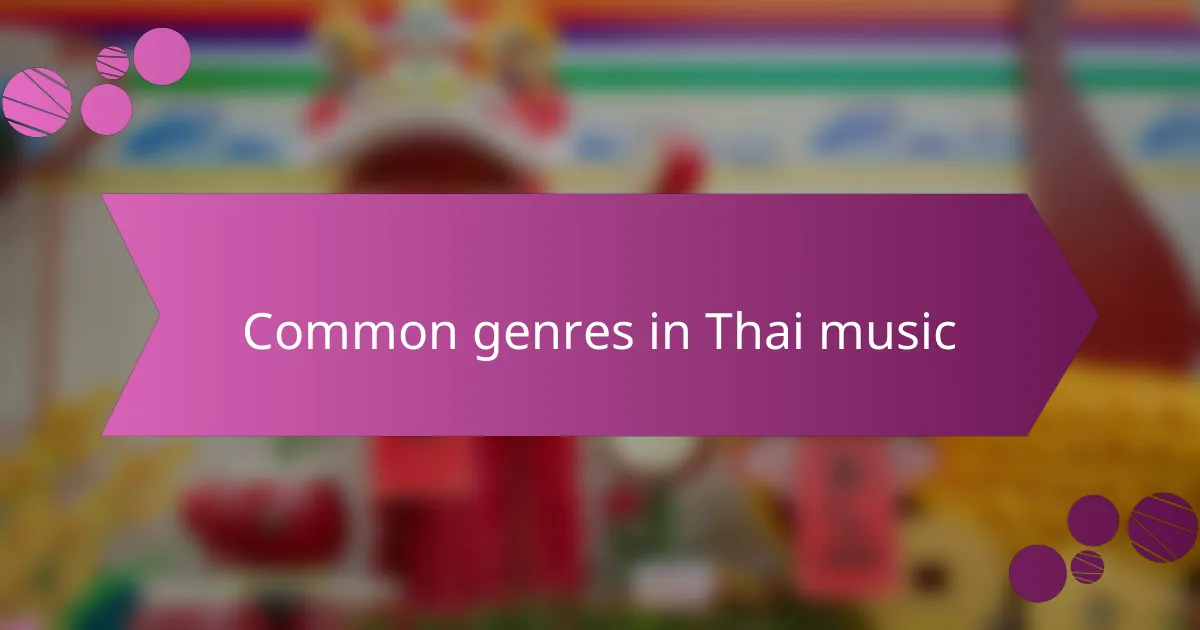
Common genres in Thai music
Each genre of Thai music presents a unique window into the country’s diverse culture. One standout genre is luk thung, which translates to “child of the rice.” This genre beautifully blends traditional Thai melodies with modern influences, often telling stories of life in rural Thailand. The first time I heard a luk thung song, I was captivated by the heartfelt lyrics and catchy rhythms that made my heart flutter with nostalgia.
Another significant genre is mor lam, originating from northeast Thailand. It’s characterized by its distinct vocal style, often accompanied by the khene, a traditional bamboo mouth organ. Listening to mor lam for the first time transported me to a bustling village gathering, where storytelling comes alive through song. The spontaneity in performances, with singers weaving tales on the spot, is thrilling and makes me appreciate the art of improvisation in music.
Lastly, there’s classical Thai music, known for its intricacies and discipline. This genre typically features orchestral ensembles, showcasing refined instruments that create enchanting melodies. Experiencing a classical performance honestly took my breath away, as the precision of each note combined with graceful dances gave life to centuries-old traditions. How inspiring it is to witness artists preserving their cultural heritage in such a beautiful way!
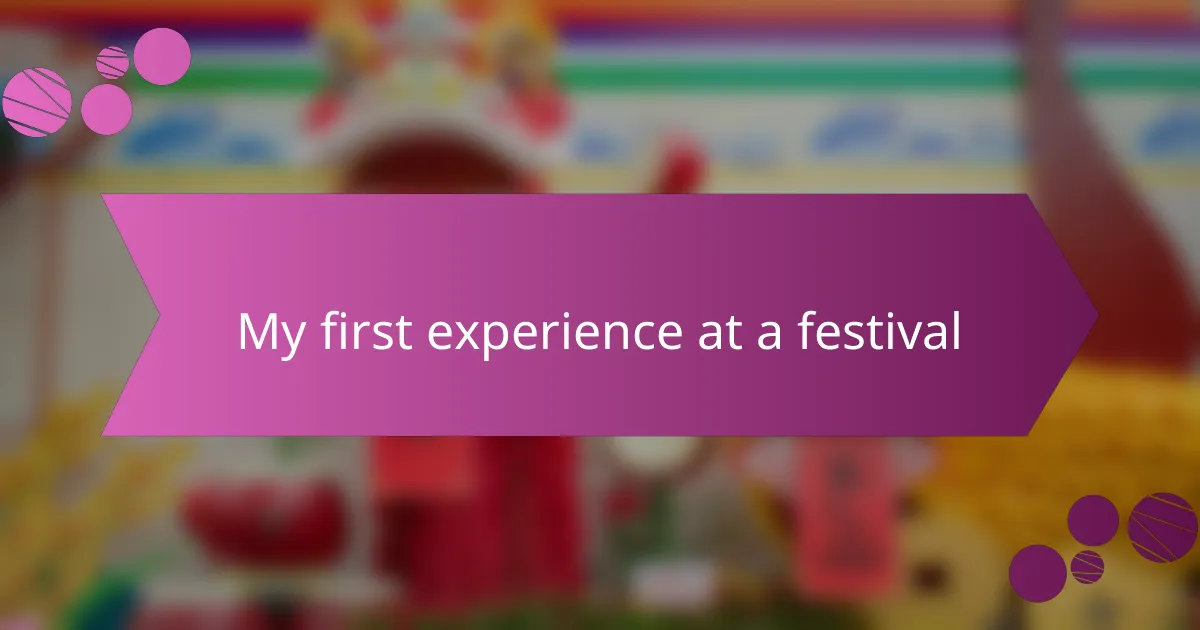
My first experience at a festival
My first experience at a Thai music festival was truly transformative. As I walked through the vibrant crowds, the enchanting rhythms of traditional Thai music filled the air, sending shivers down my spine. I remember feeling a sense of belonging as I danced with strangers, united by our love for the rich cultural expressions surrounding us.
I was particularly struck by a traditional Khon performance, where the dancers’ elaborate costumes and expressive movements vividly told stories from Thai mythology. It was more than just a performance; it was a window into the heart of Thai culture.
I often reflect on how that day opened my eyes to the power of music and dance as universal languages. Sharing laughter and joy with others, I discovered that culture truly thrives in communal experiences.
| Aspect | My First Festival Experience |
|---|---|
| Atmosphere | Vibrant and lively, filled with energy and excitement |
| Cultural Insights | Deep connection to Thai traditions and stories |
| Emotional Impact | Felt a profound sense of belonging and joy |
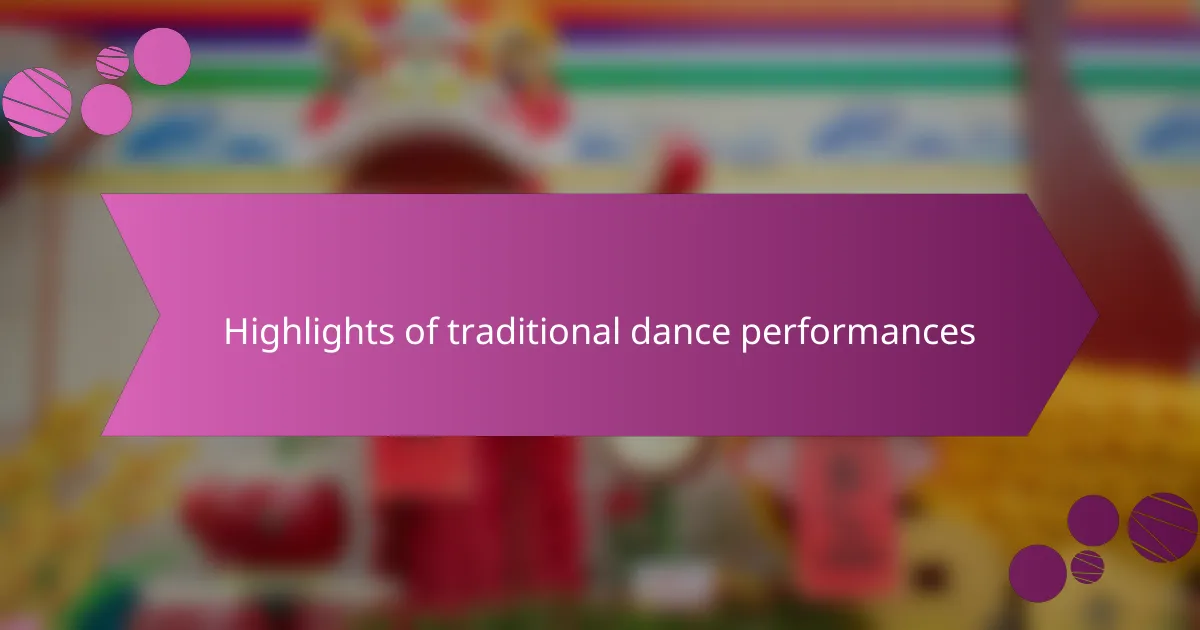
Highlights of traditional dance performances
Attending the Thai music festival, I was captivated by the highlights of traditional dance performances. Each dancer told a story through their movements, showcasing the rich heritage of Thailand. The vivid colors of their costumes, representing the flora and fauna of the country, created a mesmerizing backdrop that drew me in even further.
One performance that stands out vividly in my memory was the graceful Ram Thai dance. The intricate hand gestures and vivid [censured] expressions conveyed deep emotions, which resonated with me long after the performance ended. I found myself tapping my feet to the rhythm, feeling a connection to the culture that was palpable and personal.
Highlights:
– Colorful Costumes: Each dance featured elaborate outfits that were not only beautiful but also symbolized various aspects of Thai culture.
– Diverse Styles: From the vigorous movements of Khon to the fluidity of Lakhon, each dance showcased a unique narrative and style.
– Emotional Expression: Dancers used their bodies and expressions to convey stories, making it easy for viewers to connect with the performances.
– Live Music Fusion: Traditional instruments like the ranat (Thai xylophone) accompanied the dances, adding an intoxicating auditory layer to the visual feast.
– Community Involvement: Many performances included audience participation, creating a warm and inviting atmosphere that made everyone feel part of the celebration.
